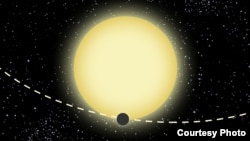Astronomers have found a new exoplanet for the first time using a method that relies on physicist Albert Einstein's special theory of relativity. These distant worlds are usually discovered by looking for stars that wobble or that dim, and identifying the orbiting planets that cause those effects.
The newly-discovered planet - formally known as Kepler-76b - was detected from three small effects that occur simultaneously as it orbits its star. One is subtle changes in the star's brightness as the planet's gravitational field causes shifts in the speed and direction of its light, as seen from Earth. This is known as Einstein's "beaming" effect.
The scientists at Tel Aviv University and the Harvard Smithsonian Center for Astrophysics also looked for signs the star was physically deformed by the planet's gravitational tides, and for reflected starlight from the planet itself.
Kepler-76b is about 25 percent larger than Jupiter and it weighs twice as much. It is located about 2,000 light-years from Earth in the constellation Cygnus.
The new planet-hunting technique cannot find Earth-sized worlds with current technology, but Avi Loeb, who first proposed the method, said it adds to astronomers' arsenal as they continue to scour the cosmos for planets that might support life as we know it.
The newly-discovered planet - formally known as Kepler-76b - was detected from three small effects that occur simultaneously as it orbits its star. One is subtle changes in the star's brightness as the planet's gravitational field causes shifts in the speed and direction of its light, as seen from Earth. This is known as Einstein's "beaming" effect.
The scientists at Tel Aviv University and the Harvard Smithsonian Center for Astrophysics also looked for signs the star was physically deformed by the planet's gravitational tides, and for reflected starlight from the planet itself.
Kepler-76b is about 25 percent larger than Jupiter and it weighs twice as much. It is located about 2,000 light-years from Earth in the constellation Cygnus.
The new planet-hunting technique cannot find Earth-sized worlds with current technology, but Avi Loeb, who first proposed the method, said it adds to astronomers' arsenal as they continue to scour the cosmos for planets that might support life as we know it.











